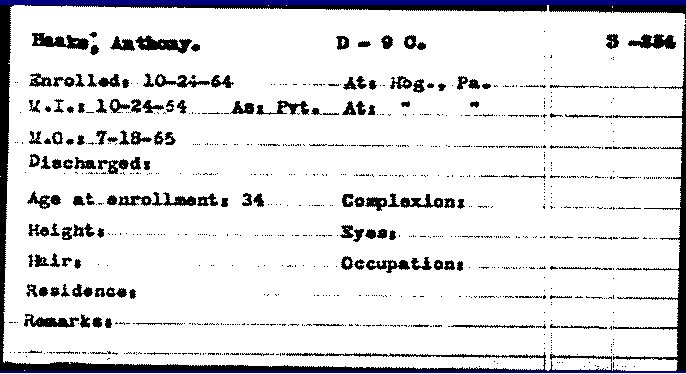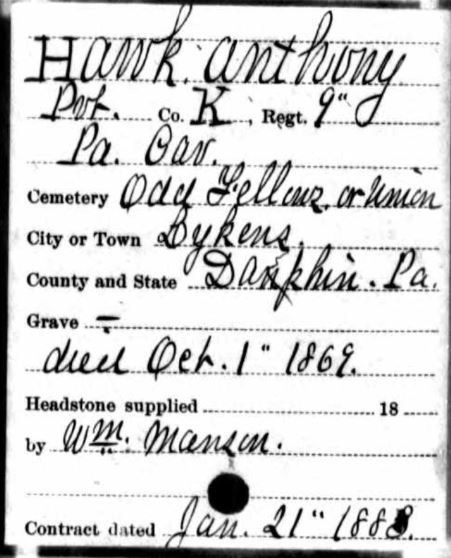Anton Haake – 9th Pennsylvania Cavalry – Not Recognized on Lykens Monument
Posted By Norman Gasbarro on July 22, 2016
On 24 October 1864, Anthony “Anton” Haake, aged about 34, enrolled at Harrisburg in the 9th Pennsylvania Cavalry, Company D, as a Private. He was honorably discharged on 18 July 1865, and the record shows that he returned to his home in Lykens, Dauphin County, Pennsylvania.
The return to Lykens is known because when he died there on 1 October 1869, his obituary indicated that he had lived in Wiconico Township, of which Lykens is a part, for 20 years.
In a recent post on his blog Wynning History, Jake Wynn described how Anton died on 1 October 1869 by falling off the railroad bridge over the Wiconisco Creek while in a “state of intoxication.” He hit the stony bottom of the creek and was found by a railroad worker. The coroner’s jury ruled the death accidental, but alcohol was a contributing factor. The article describing Anton’s death appeared in the Harrisburg Telegraph, 2 October 1869. Previous to reading Jake’s blog post, Anton had not been included in the Project‘s Civil War list of veterans, although he had been mentioned as “Anthony Hawk” in a prior post on the Civil War Draft of 1863.
The article also indicated that Anton’s remains were committed to rest in the Catholic Cemetery in Lykens.
In searching the database “Headstones Provided for Deceased Union Civil War Veterans,” on Ancestry.com, a card was found for Anthony Hawk, in Company K, of the 9th Pennsylvania Cavalry. This is clearly the same person since the death date is the same – 1 October 1869. However, the cemetery designation as “Odd Fellows” or “Union” in Lykens is confusing in that neither of these cemeteries is considered to be the “Catholic” cemetery in which Anton was supposedly interred.
The Lykens cemeteries are all located south of the Main Street of the borough. In all, there are seven distinct areas as noted on the above map supplied by Sally Reiner of the Lykens-Wiconisco Historical Society. From the East (or left side of the map), the seven cemeteries are: (1) Irish Catholic Cemetery; (2) Greek Orthodox Cemetery; (3) G.A.R. Cemetery; (4) Odd Fellows Cemetery*, or I.O.O.F. Cemetery; (5) Roman Catholic Cemetery; (6) P.O.S. of A. Cemetery; and (7) Union Cemetery (Lutheran & Reformed)*, also known as Citizens’ Cemetery, the oldest cemetery in the borough. The cemeteries for which there are published lists in geographical format are marked with an asterisk. These cemeteries are on the side of a mountain and are difficult to traverse and photograph. Many of the stones cannot be located and some have surely been removed. However, in the case of Anthony Hawk, a Findagrave Memorial has been created and his stone is pictured there. The photograph, according to site information, was uploaded on 13 August 2013.

The grave marker at that site is of military issue and alongside the marker is a G.A.R. Star-Flag Holder. But is this marker in the Odd Fellows [I.O.O.F] section of the cemetery? A search of the published geographical list of that cemetery section indicates that this burial is not recorded there. Likewise, a search of the two other sections of the cemetery for which there are published lists [P.O.S. of A. and Union] reveals the same results. Is it possible that the burial was actually made in one of the Catholic sections which does not have a published list? The death notice would seem to indicate that he was buried in the Catholic Cemetery:
His remains were taken in charge by the township [Wiconisco], and deposited it Tuesday in the Catholic Cemetery.
The actual, physical location of the government-issued stone has not been determined, and is not given in the Findagrave Memorial. The combined Lykens cemeteries are difficult to traverse because they are on the side of a hill or mountain, and when this area was last “walked” to photograph for this Civil War Project, the ground was leaf-covered and rocky, and this stone was not seen. Perhaps someone who has recently visited the cemetery can give an exact location of this grave marker (GPS coordinates) and report back to this blog with a comment or e-mail.
Finally, in relation to the government issued marker, there are other records available, including the actual application for the stone, which apparently was made several years after Anton’s death. That application should contain the name of the applicant – which may have been someone from the G.A.R. or from the Catholic Church in Lykens. But, that application was not located on Ancestry.com.
Another point of analysis is made on the residency of Anton Haake. The death notice states the following:
The deceased had been a resident of this township for upwards of twenty years….
A search of the township and borough censuses for 1850 and 1860 produced no good results under the name of Anton Haake, Anthony Hawk, or any similar name.
But previously, on this blog, the name of Anthony Hawk, was mentioned as a draftee in 1863, and a resident of Wiconisco Township and Lykens Borough. See: The 1863 Draft for Upper Dauphin County.
The comment in the death notice, that he had traveled to Germany to visit his mother in 1867 is borne out by a ship list found for 1867 which shows that he arrived in New York from Bremen on 11 June 1867 and his original immigration record could be possibly be found in one of several pre-Civil War arrival lists in New York found on Ancestry.com. However, mid-19th Century lists do not give information such as the destination in the United States, although they do contain the age of the traveler, the date of arrival, the points of departure and arrival, and the name of the ship.
Genealogical information about Anton Haake, including birth and parents, can probably be found in German records, which have not been consulted for this blog post. Anyone who has obtained these records and can provide any insight into his past, is urged to contact the Project.
Likewise, the military index cards which reference the muster rolls of the 9th Pennsylvania Cavalry, have not been consulted for this blog post. Those cards could give a better understanding of the campaigns and battles in which Anton participated, as well as any injuries he may have received and any incidents which may have contributed to his post-war alcoholism. If anyone reading this post has obtained those cards from the National Archives, sharing them with the Project could help in drawing conclusions as to why he “was known as a man of dissipated habits.”
No Pension Index Card was located for Anton Haake, either in Ancestry.com or in Fold3. This would not be unusual if he had not been physically injured during the war, as only those whose physical injures could be directly war-related were eligible to apply in 1869 when Anton died. And, since the death notice indicates that he was “unmarried,” no widow would have made application in the years after. Previously on this blog, a post entitled “Pvt. Peter W. Miller – Mental Health & the Civil War,” explored the topic of emotional and mental scarring as a result of Civil War experiences.
Finally, the last comment in the death notice, that he had been “employed at the time of his death at the new operation of the Lykens Valley Coal Company,” may provide a lead to finding more information about him, but that would involve searching the records of the coal company and it is not known at this time what, if any records have survived and are available.
Curiously, if Anton Haake had been living in the Lykens area for “upwards of twenty years,” he apparently was completely forgotten (or intentionally ignored) when, at the beginning of the 20th Century, the list of names to be placed on the Lykens G.A.R. Monument was compiled. In a prior post here on this blog, the efforts to compile an “accurate list” of area veterans who should have been named on the monument were discussed. Those efforts were chiefly conducted by Henry Keiser, whose career as a clerk in the Lykens coal companies and his active participation in the Lykens G.A.R. Post were well-known in the area. Keiser, who lived in Lykens, was certainly familiar with the Lykens cemeteries and who was buried there, and the evidence indicates that the government-issued grave marker was contracted in 1888 (see above, “Headstones Provided”). Someone had to “speak” for Haake in ordering the stone and it is odd that in 1888, the Heilner G.A.R. Post in Lykens was very active. The grave marker also should have been present in the cemetery in 1925 when the list of soldiers was compiled by Keiser. Why then was he not named on the monument?
While it cannot be concluded with any certainty that Anton Haake’s name was not included on the monument because he was Catholic, further research should be conducted to determine if there was a pattern to exclude veterans because of their religion.
A 1906 incident in neighboring Williamstown, Dauphin County, resulted in the local G.A.R. Post being “severely rebuked” for its bigotry against Catholics. See: Williamstown G.A.R. Post Severely Rebuked for Bigotry. And, an African American Civil War veteran, a native of Gratz, lies unrecognized in the present as a result of the bigotry of a local historical society that doesn’t want it known that African Americans ever lived in or were part of the history of that community. See: Edward Crabb – Victim of Bigotry in Gratz.
Note: Jake Wynn was a contributor to this Civil War Blog during his college years. All of his posts can be found in the blog archive.
 ;
;





Comments